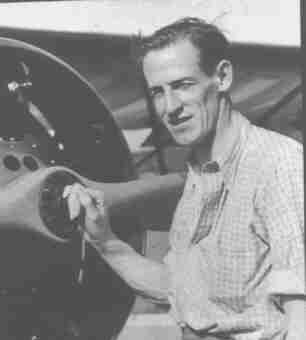
Myles Reginald ANSETT (1909-1981)

Myles Reginald ANSETT (1909-1981)
AvStop Online Magazine
Australia Aviation History
Pilots That Were Pioneers In Aviation
Reg was born near Bendigo, Victoria. His father operated a cycle repair shop developed into a motor garage and he fought in W.W.1 in the Australian Imperial Force (mother moved to Camberwell , Melbourne , mean- while), but on returning opened a knitting business and Reg started working there, attending Swinburn Technical College at night. Flying lessons followed in 1929. After being an axeman for a survey party in Northern Australia, saving all the time, he entered the road transport business in competition with Victoria Railways, being driver, mechanic and manager. In 1935 he registered Ansett Airways Pty. Ltd., and bought a 6 seat Fokker for passenger work, in the region, hiring his Gipsy Moth for aerobatic flights at 30 shillings a time.
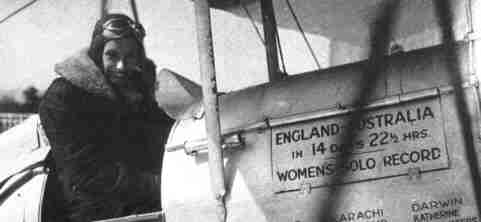
Jean BATTEN
He started a fleet of passenger aircraft (including an Airspeed Envoy) and moved to Essendon, Melbourne, developing flight routes to Adelaide and Sydney. When the ban on non-British aircraft was lifted in 1937 he bought 3 Lockheed Electras with great financial difficulty. Then he had to deal with attempts to sell the airline under him to a rival airline called A.N.A. During W.W.2 his network of maintenance sections and personnel increased under American Military Contracts. By 1945 his airline had 2000 employed and he offered cheap fares operating for the holiday makers with older aircraft. About that time too the Government created T.A.A. to dominate the airlines with their fleet of Convair CV240s and and Vickers Viscounts. A.N.A. continued to be a rival but with less efficiency. In 1954 Ansett introduced CV340s to compete with T.A.A. and in 1957 absorbed A.N.A. In the late 50s the 'Two Airline Policy' came into effect, T.A.A. being government run, and Ansett-A.N.A.
So parallel flying on most commercial routes commenced. (Take-off sometimes being separated by 5 minutes only !) Other interests were T.V. Stations, Hotels and Resorts, Coach and Road Freight Transport and Securities.He died in December 1981,still at the helm, handing over to Rupert Murdoch and Sir Peter Abeles (TNT). (Reference "Ansett", Samuel Brimson) Born in New Zealand (who cares so long as they play good rugby ! Ed.) ,the piano was sold to pay for flying lessons at Stag Lane , U.K. ! She flew from England to Australia and back in record time solo in 1934 and broke the solo record across the Atlantic in 1935. In 1936 she went solo from England to New Zealand in 11 days, a record not broken until 1980. In 1937 she again flew solo from England to Australia to regain the record from Harry Broadbent.
In a Gipsy Moth, she flew round the coast of Australia in August/September 1932 and had a number of forced landings with minor troubles. Even a collision with the escort plane did not deter her. She aimed at the record from Australia to England in 1933 (following Amy Johnson's reverse flight earlier) . She flew to Singapore and was food poisoned at Raffles Hotel, but took off into a monsoon and had to land on the beach. She swerved into the water avoiding a stray buffalo and overturned. After the wave receded she unbuckled, crawled out and was helped by islanders in salvaging the plane. The repairs in Rangoon took a while but she finally reached Europe but was arrested in both Turkey and Czechoslovakia for 'unapproved' landings. Landing in England she was almost rolled over by a Handley-Page airliner landing in front of her. She flew through storms and two forced landings to South Africa from Australia in 1937. She was alive in 1991 at 93 and received the Order of Australia.
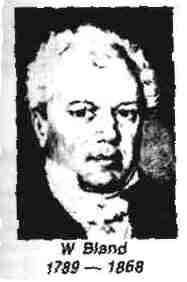
Dr. William BLAND


Lores BONNEY
In 1929 he discovered 'Kookaburra ' Keith Anderson's crashed plane during the 'Coffee Royal' incident( see Kingsford Smith). In 1936 he flew the first DH86 ( a four engined passenger biplane) from England for use in Australia by QANTAS(they eventually had four). After making changes to the fin post fittings , directional stability improved and the plane proved reliable. He eventually rose to become chairman of The Australian National Airlines Council ( later TAA , finally part of QANTAS) in 1946 , having previously been Operations Manager. (Australian Aviators) Born in Geelong, Victoria (son of a farmer) he moved to Perth when young and saw a Spaniard in 1910 go up in a balloon and parachute. In W.W.1 he sailed to England 'as seventh engineer' in the crew and was interviewed for the Army by 'Plum' Warner, the famous cricketer; then into the R.F.C.. He went solo in a Farman Longhorn in under two hours after an argument with his instructor, night flying in seven! 19th Century Sydney surgeon Designer of the Atomic Ship literally Greek for vapour in 1851. (He had been transported as a convict for killing a ship's purser in a duel but quickly pardoned) and became Australia's first private doctor. The ship, or balloon's design, carrying 1.5 tons of passenger and freight in 4.5 days from Sydney to London. It had a steam engine and studded sails but was never built. He died in 1868 after dabbling in politics and founding the Australian Medical Association, also being treasurer of Sydney Free Grammar School.

On the Western Front he was badly shot up, only just reaching 'no man's land' between the lines and was forced to hide in a shell hole while the aircraft was shelled. An armour piercing bullet was removed by a surgeon later and he became a 'Gosport' flying instructor in the U.K., after insisting on returning to flying. After W.W.1 he brought two Avros to Western Australia, firstly barnstorming, then developing airmail routes in the North West of W.A. He was awarded the first commercial flying licence in Australia. He founded Western Australian Airways Ltd. In 1921 hiring some famous pilots of the era flying Bristols.
The first regular airmail contract, in Western Australia, was awarded in December, 1921, covering 1200 miles between Geraldton and Derby. Later W.A. Airways won the Perth-Adelaide airmail contract using D.H.66 Hercules. As this operation entailed night landings, he had a difficult time with the Department of Civil Aviation who insisted on unsuitable runway lighting. He finally used his own choice of lighting and the 2400 km route commenced. Always 'leading from in front' he flew many legs himself. On one of the flights ,in dense fog at Port Wakefield, South Australia ,he narrowly missed a mill chimney during a low turn. In 1936 he sold the airline to the Orient shipping line to become A.N.A. (see AIRLINES) later on. As an engineer who also flew he did a great deal for early airline development as his was considered a model operation.

Sir Norman BREARLEY

The first woman to gain a pilot's license (28/3/27) , here seen with Cpt. Leggatt, presumably her examiner. She paid about 1 pound per hour for tuition , which was then a weeks wages. Later that year she was drowned in the Greycliff ferry accident. Originally from Lithgow, N.S.W., in 1932 he flew the smallest aircraft to fly from England directly to Australia, beating C.W.A. Scott's record with a flight of 9 days 2 hours 29 minutes in a Comper- Swift. A thief stole 15 gallons of his petrol at Akyab, Burma during this flight.) Later he went on to design a high winged , all metal plane capable of 185mph but he couldn't sell it. He also founded Butler Air Transport (D.H.84 Dragon, Douglas D.C.3c,D.H.114 Heron, Airspeed Ambassador and Vickers Viscount aircraft) . This, on takeover by R.M. Ansett , became Airlines of N.S.W.. Trying to enlist at Pt.Cook for W.W.1 he became frustrated with the delay and went to the U.K. instead. There he enlisted as an Air Mechanic ,ending up as a Captain flying instructor, going to France to learn battle techniques and winning the D.F.C. on the way.

Millicent Maud BRYANT
After war service he formed a joint company with H. Kauper called The Harry Butler & Kauper Aviation Company in South Australia (1920). He flew an Avro 504 and a Bristol M.1.c.fron his Albert Park field which later became Adelaide's first airport before Parafield was developed. He started the first air mail service (to York Peninsular) and aerial photography for the press . In W.W.1 in No. 4 Squadron, Cobby shot down 32 enemy planes as well as 13 balloons. He took on two of Manfred Richthofen's Circus and downed them in one dog fight. He later became an Air Commodore in W.W.2 In 1920 he flew the then Governor , Sir Henry Galway for 40 minutes and he won the first Australian Aerial Derby in September of that year. He was well known in the State for barnstorming flights and finally crashed badly with a passenger south of Minlaton and never flew again. His plane ,'The Red Devil' , is on display in that town donated by Horrie Miller after restoration. An oral history tape by his wife is in the Mortlock Library, Adelaide. (The Harry Butler Story by Minlaton District Council,S.A.)
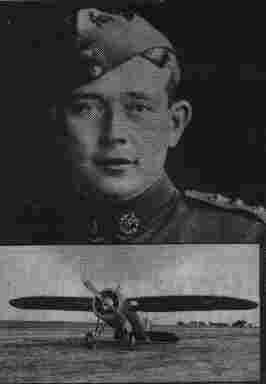
Capt. Harry J. BUTLER

Testing an early design in early 1910 he soberly stated it was a toss up whether the machine stood still and the propeller revolved or vice-versa (aero-modellers may sometimes have the problem!) In July, 1910,he made a 24 ft.' hop' at Spring Plains Estate, near Mia Mia , Victoria, It was the first flight by an Australian designed and built aircraft and it is preserved in the Science Museum, Victoria.
Three months later he flew 196 yards 12 feet aloft at 40 m.p.h., later doing a circuit. He did not, however, go for the Federal Government prize, like others.
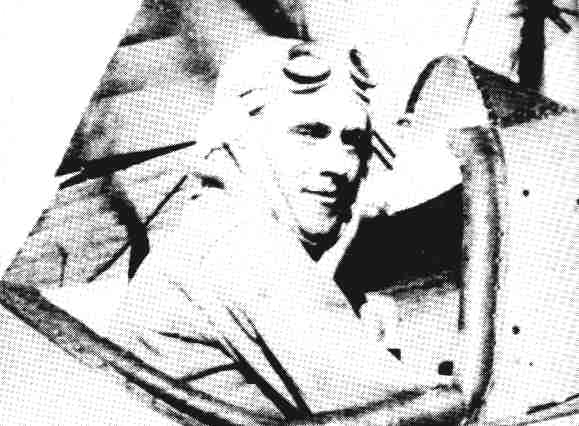
Fred C. CUSTANCE
On 17th March, 1910, at Bolivar, near Adelaide, South Australia, he flew for a short period, ending in a 'very rough landing', witnessed by FH Jones ,the owner of the property and neighbors. ((NOTE It is on record that Bill Wittber (which see under W) made a 'hop' earlier on 13th.of that month to be the first' controlled' flight)) . A day later, in Melbourne, Harry Houdini (an American escapologist showman) made a more public flight which some claim to be the first (confusing isn't it?). On Custance's second flight he over-corrected the elevator and crashed, damaging the plane, a Bleriot imported by the said F.H. Jones. During W.W.1 he flew BE2cs in Palestine with No. 1 Sqdn, creating a flight record from Cairo to Romani in 40 hours. Returning after the war he obtained the 'Caterpillar' tractor agency. He died of 'exhaustion' aged 33 in the South Australian desert after a car breakdown.
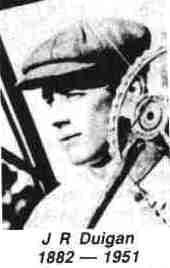
JOHN ROBERTSON DUIGAN

COLIN DEFRIES
On 18th December 1909 in Sydney's Victoria Racecourse he flew 300 yards at 2 to 15 feet uncertainly. His hat blew off, he reached out to grab it and forced landed with some damage. This was not considered controlled flight however. Fred Custance did it better on 17 March 1910.